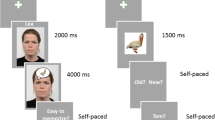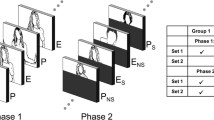Abstract
Enhanced emotional memory (EEM) describes memory benefits for emotional items, traditionally attributed to impacts of arousal at encoding; however, attention, semantic relatedness, and distinctiveness likely also contribute in various ways. The current study manipulated arousal, semantic relatedness, and distinctiveness while recording changes in event-related potentials and heart rate during memory encoding. Trials were classified as remembered or forgotten by immediate recall performance. Negative images were remembered significantly better than neutral, and related neutral images were remembered significantly better than unrelated neutral images. Higher P300 and late positive potential (LPP) amplitudes were associated with memory for negative images as compared with related neutral images, suggesting that negative images received additional attentional processing at encoding, and that this cannot be accounted for only by the inherent relatedness of negative stimuli. No encoding benefits were found for related neutral images though they were better remembered than unrelated neutral images, indicating retrieval dynamics impacted memory. When image types were intermixed, greater heart rate changes occurred, and negative and unrelated neutral images received increased elaborative processing as compared with related neutral images, perhaps due to the prioritization of encoding resources. These results suggest encoding and retrieval processes contribute to EEM, with emotional items benefiting additively.





Similar content being viewed by others
References
Anderson, A. K., & Phelps, E. A. (2001). Lesions of the human amygdala impair enhanced perception of emotionally salient events. Nature, 411, 305–309.
Barnacle, G. E., Montaldi, D., Talmi, D., & Sommer, T. (2016). The list-composition effect in memory for emotional and neutral pictures: Differential contribution of ventral and dorsal attention networks to successful encoding. Neuropsychologia, 90, 125–135.
Barnacle, G. E., Tsivilis, D., Schaefer, A., & Talmi, D. (2018). Local context influences memory for emotional stimuli but not electrophysiological markers of emotion-dependent attention. Psychophysiology, 55(4), e13014.
Beck, A. T., Ward, C. H., Mendelson, M., Mock, J., & Erbaugh, J. (1961). An inventory for measuring depression. Archives of General Psychiatry, 4, 561–571.
Beck, A. T., Epstein, N., Brown, G., & Steer, R. A. (1988). An inventory for measuring clinical anxiety: Psychometric properties. Journal of Consulting and Clinical Psychology, 56(6), 893–897.
Blumenfeld, R. S., & Ranganath, C. (2007). Prefrontal cortex and long-term memory encoding: An integrative review of findings from neuropsychology and neuroimaging. The Neuroscientist, 13(3), 280–291.
Bradley, M.M. & Lang, P.J. (2007) Emotion and motivation. In Cacioppo, J. T., Tassinary, L. G., & Berntson, G. (Eds.). Handbook of psychophysiology. Cambridge university press. p.581–607.
Bradley, M. M., Greenwald, M. K., Petry, M. C., & Lang, P. J. (1992). Remembering pictures: Pleasure and arousal in memory. Journal of Experimental Psychology: Learning, Memory, and Cognition, 18(2), 379–390.
Buchanan, T. W., Etzel, J. A., Adolphs, R., & Tranel, D. (2006). The influence of autonomic arousal and semantic relatedness on memory for emotional words. International Journal of Psychophysiology, 61(1), 26–33.
Collins, A. M., & Loftus, E. F. (1975). A spreading-activation theory of semantic processing. Psychological Review, 82, 407–428.
Cunningham, W. A., Espinet, S. D., DeYoung, C. G., & Zelazo, P. D. (2005). Attitudes to the right-and left: Frontal ERP asymmetries associated with stimulus valence and processing goals. NeuroImage, 28(4), 827–834.
Cuthbert, B. N., Schupp, H. T., Bradley, M. M., Birbaumer, N., & Lang, P. J. (2000). Brain potentials in affective picture processing: covariation with autonomic arousal and affective report. Biological Psychology, 52(2), 95-111.
Dan-Glauser, E. S., & Scherer, K. R. (2011). The Geneva affective picture database (GAPED): A new 730-picture database focusing on valence and normative significance. Behavior Research Methods, 43(2), 468–477.
Dewhurst, S. A., & Parry, L. A. (2000). Emotionality, distinctiveness, and recollective experience. European Journal of Cognitive Psychology, 12(4), 541–551.
Doerksen, S., & Shimamura, A. P. (2001). Source memory enhancement for emotional words. Emotion, 1(1), 5–11.
Donchin, E., & Coles, M. G. (1988). Is the P300 component a manifestation of context updating? Behavioral and Brain Sciences, 11(3), 357–374.
Herring, D. R., Taylor, J. H., White, K. R., & Crites Jr., S. L. (2011). Electrophysiological responses to evaluative priming: The LPP is sensitive to incongruity. Emotion, 11(4), 794–806.
Hunt, R. R. (2006). The concept of distinctiveness in memory research. Distinctiveness and memory, 3–25.
Jennings, J., & Hall, S. (1980). Recall, recognition, and rate: Memory and heart. Psychophysiology, 17(1), 37–46.
Kamp, S. M., Potts, G. F., & Donchin, E. (2015). On the roles of distinctiveness and semantic expectancies in episodic encoding of emotional words. Psychophysiology, 52(12), 1599–1609.
Kensinger, E. A. (2007). Negative emotion enhances memory accuracy: Behavioral and neuroimaging evidence. Current Directions in Psychological Science, 16(4), 213–218.
Lang, P. J., Bradley, M. M., & Cuthbert, B. N. (1999). International affective picture system (IAPS): Technical manual and affective ratings. NIMH Center for the Study of Emotion and Attention.
Mather, M., & Sutherland, M. R. (2011). Arousal-biased competition in perception and memory. Perspectives on Psychological Science, 6(2), 114–133.
McKenna, F. P., & Sharma, D. (1995). Intrusive cognitions: An investigation of the emotional Stroop task. Journal of Experimental Psychology: Learning, Memory, and Cognition, 21(6), 1595–1607.
Mickley Steinmetz, K. R., & Kensinger, E. A. (2013). The emotion-induced memory trade-off: More than an effect of overt attention? Memory & Cognition, 41(1), 69–81.
Olofsson, J. K., & Polich, J. (2007). Affective visual event-related potentials: Arousal, repetition, and time-on-task. Biological Psychology, 75(1), 101–108.
Olofsson, J. K., Nordin, S., Sequeira, H., & Polich, J. (2008). Affective picture processing: An integrative review of ERP findings. Biological Psychology, 77(3), 247–265.
Phelps, E. A., Labar, K. S., Anderson, A. K., O’Connor, K. J., Fulbright, R. K., & Spencer, D. D. (1998). Specifying the contributions of the human amygdala to emotional memory: A case study. Neurocase, 4(6), 527–540.
Polyn, S. M., Norman, K. A., & Kahana, M. J. (2009). A context maintenance and retrieval model of organizational processes in free recall. Psychological Review, 116(1), 129–156.
Reisberg, D., & Heuer, F. (2004). Memory for emotional events. In D. Reisberg & P. Hertel (Eds.), Series in affective science. Memory and emotion (pp. 3–41). New York: Oxford University Press.
Riggs, L., McQuiggan, D. A., Farb, N., Anderson, A. K., & Ryan, J. D. (2011). The role of overt attention in emotion-modulated memory. Emotion, 11(4), 776–785.
Sara, S. J., & Bouret, S. (2012). Orienting and reorienting: The locus coeruleus mediates cognition through arousal. Neuron, 76, 130–141.
Schmidt, S. R. (1991). Can we have a distinctive theory of memory? Memory & Cognition, 19(6), 523–542.
Schmidt, S. R., & Saari, B. (2007). The emotional memory effect: Differential processing or item distinctiveness? Memory & Cognition, 35(8), 1905–1916.
Sommer, T., Gläscher, J., Moritz, S., & Büchel, C. (2008). Emotional enhancement effect of memory: Removing the influence of cognitive factors. Learning & Memory, 15(8), 569–573.
Talmi, D., & McGarry, L. M. (2012). Accounting for immediate emotional memory enhancement. Journal of Memory and Language, 66, 93–108.
Talmi, D., & Moscovitch, M. (2004). Can semantic relatedness explain the enhancement of memory for emotional words? Memory and Cognition, 32, 742–751.
Talmi, D., Luk, B. T. C., McGarry, L. M., & Moscovitch, M. (2007a). The contribution of relatedness and distinctiveness to emotionally-enhanced memory. Journal of Memory and Language, 56, 555–574.
Talmi, D., Schimmack, U., Paterson, T., & Moscovitch, M. (2007b). The role of attention and relatedness in emotionally enhanced memory. Emotion, 7(1), 89–102.
Talmi, D., Lohnas, L. J., & Daw, N. D. (2017). A retrieved context model of the emotional modulation of memory.
Thomas, S. J., Johnstone, S. J., & Gonsalvez, C. J. (2007). Event-related potentials during an emotional Stroop task. International Journal of Psychophysiology, 63(3), 221–231.
Todd, R. M., Lewis, M. D., Meusel, L. A., & Zelazo, P. D. (2008). The time course of social-emotional processing in early childhood: ERP responses to facial affect and personal familiarity in a Go-Nogo task. Neuropsychologia, 46(2), 595–613.
Watts, S., Buratto, L. G., Brotherhood, E. V., Barnacle, G. E., & Schaefer, A. (2014). The neural fate of neutral information in emotion-enhanced memory. Psychophysiology, 51, 673–684.
Weinberg, A., & Hajcak, G. (2010). Beyond good and evil: The time-course of neural activity elicited by specific picture content. Emotion, 10(6), 767–782.
Wessa, M., Kanske, P., Neumeister, P., Bode, K., Heissler, J., & Schonfelder, S. (2010). EmoPics: Subjective and psychophysiological evaluations of new visual material for clinical-bio-psychological research. Journal of Clinical Psychology and Psychotherapy, 1(11), 77.
Yao, Z., Yu, D., Wang, L., Zhu, X., Guo, J., & Wang, Z. (2016). Effects of valence and arousal on emotional word processing are modulated by concreteness: Behavioral and ERP evidence from a lexical decision task. International Journal of Psychophysiology, 110, 231–242.
Author information
Authors and Affiliations
Corresponding author
Ethics declarations
Acknowledgments
We would like to thank Avery Jucksch, Katherine Covington, Mariel Teigen, Margaret Roach, Savannah Patterson, Sheldon Newman, Hunter Wages, Turner Bryant, Nick Butler, Caroline Wilson, Jake Philips, and Catie Cronister for their contributions to this work and Wofford College for funding. We would also like to thank Dr. G. Andrew Mickley for comments on a previous version of this draft and Dr. Matthew Cathey for statistical guidance.
Funding Information
The authors received funding from Wofford College.
Data Availability
Data are available here https://osf.io/4kj6f/.
Conflict of Interest
The authors declare that they have no conflict of interest.
Ethical Approval
This study was approved by the Wofford College Institutional Review Board and the study was performed to ethical standards as laid down in the 1964 Declaration of Helsinki.
Informed Consent
Informed consent was obtained from all research participants. No experiments were pre-registered. Consent to publish is given.
Additional information
Handling editor: Elizabeth Kensinger
The submitted work has not been published previously and is not being considered for publication elsewhere.
Electronic Supplementary Material
ESM 1
(PDF 457 kb)
Rights and permissions
About this article
Cite this article
Zarubin, V.C., Phillips, T.K., Robertson, E. et al. Contributions of Arousal, Attention, Distinctiveness, and Semantic Relatedness to Enhanced Emotional Memory: An Event-Related Potential and Electrocardiogram Study. Affec Sci 1, 172–185 (2020). https://doi.org/10.1007/s42761-020-00012-y
Received:
Accepted:
Published:
Issue Date:
DOI: https://doi.org/10.1007/s42761-020-00012-y




